Top 5 Safest Playground Surfaces (with Photos)
22 Jul, 2024
- How does the playground surface impact safety?
- What are the key features of a safe playground surface?
- Top 5 safest playground surfaces
- 1. Poured-in-place rubber surfacing
- 2. Engineered Wood Fiber
- 3. Rubber Tiles
- 4. Rubber Mulch
- 5. Synthetic Turf
- What is the safest playground surface?
- Materials to avoid
- Ensuring safety and compliance: Playground safety standards
- 1. CPSC
- 2. ASTM International
- 3. ADA
- 4. CSA
- Final thoughts
When it comes to building a playground, it is essential to apply a surface that provides a safe environment. After all, the task of playgrounds is not only to be nice and fun, but also to be safe for children. You need to choose those playground surface materials that absorb shock well, prevent injuries and soften falls.
In this article we will look at different surface options, their features, advantages and disadvantages to understand what is the safest playground surface, thereby helping you make a good choice.
How does the playground surface impact safety?
The playground safety surface is a critical aspect. On the playground, children can play and have too much fun, leading to falls due to carelessness.
According to the Consumer Product Safety Commission (CPSC), falls account for about 70% of all playground injuries. This means that the main step to making the playground safe is to choose a soft and thick surface for children to land on.
A good shock absorber material already significantly minimizes the risk of injury that kids can get. So, to build a great playground that meets the requirements and prevents serious damage, the first place to start is choosing safety surfaces for playgrounds.
What are the key features of a safe playground surface?
Safety surfaces for playgrounds must meet requirements regarding non-toxic materials, shock absorption, critical fall height, coating thickness, slip resistance, and accessibility.
Key safety aspects include:
- Compliance with standards (CPSC, ASTM, ADA, CSA)
- Good shock absorption and fall cushioning
- No sharp edges or irregularities
- Durability and sustainability of the surfacing
- Eco-friendly and non-toxic material
Top 5 safest playground surfaces
There are many safe surfaces for playgrounds, which come with their pros and cons. They fall into two major groups: loose-fill and unitary.
Loose-fill surfaces consist of multiple small pieces evenly spread over the ground. Common examples include engineered wood fiber or rubber mulch. Loose-fill materials are more affordable than most unitary options; however, they call for frequent maintenance and refills.
On the other hand, unitary materials are poured into the playground area and then cured to create a level shock-absorbing surface. Although unitary surfaces are costlier, they don’t require much maintenance.
When choosing a surface material for your play area, you should take into account your unique needs and circumstances. All safe playground surfaces do their job well, but they are different in terms of affordability, maintenance, and sustainability. Long story short, here’s the top 5 list of the safest playground surfaces to help you make a more informed choice.
1. Poured-in-place rubber surfacing
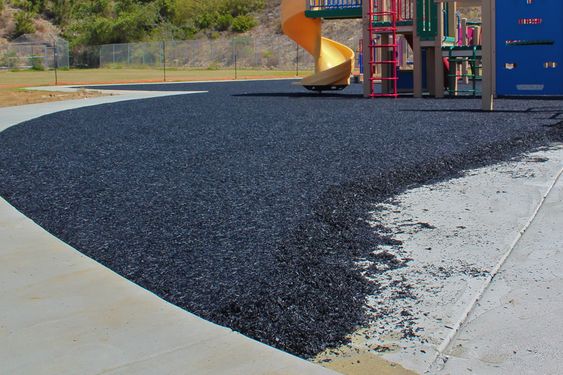
Pour-in-place playground surface, also known as poured rubber or PIP, is a smooth layer of rubber evenly covering the playground surface. Poured-in-place rubber features two layers: a shock-absorbing crumb rubber layer and a topcoat. The thickness of poured-in-place rubber surfaces typically ranges between 2.5 to 3.5 inches.
Long-lasting, low-maintenance, and durable, poured rubber is one of the most popular choices for playground surfacing. In addition, it’s more customizable than any other playground surface — it exists in a variety of colors and designs, making your playground stand out.
Moreover, poured rubber comes with low maintenance costs and is relatively easy to clean with water and detergent. Finally, the poured-in-place surfacing is perfectly smooth, making the playground easily accessible for people on mobility devices.
Poured-in-place rubber is one of the most expensive to install, so you’ll mostly see it at resorts or amusement parks rather than public playgrounds.
Advantages
- High shock absorbency (fall height rating at 16 feet)
- Highly customizable
- Sustainable
- Low-maintenance
- Accessible
- Durable
- Long-lasting (up to 10 years)
Disadvantages
- Expensive
- Likely to harden over time when exposed to UV light or extreme temperatures
2. Engineered Wood Fiber
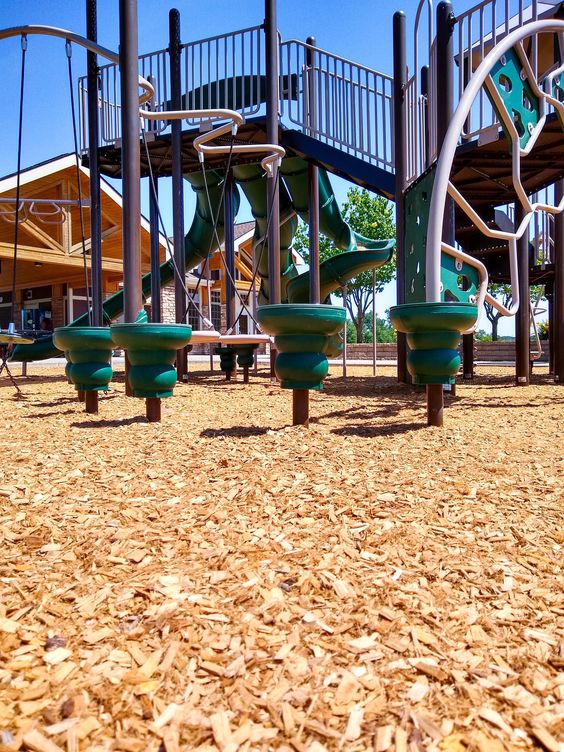
Engineered wood fiber (EWF) is loose-fill material produced from manufactured wood. However, it’s different from common wood chips since it’s free of bark and twigs and is processed to make it softer.
EWF is the safest of all loose-fill options and is less expensive than other materials. It’s an excellent solution for a natural playground as it creates a natural look. Engineered wood fiber is characterized by good shock absorbency. It’s easy to install; however, it’s bound to be displaced in high-traffic areas, for instance, under swings.
Given that, wood fiber surfacing calls for frequent maintenance — constantly monitoring its depth, raking displaced material back into place, and topping it up to accommodate the fall heights of the play equipment.
Similar to any other loose-fill surfacing, EWF questions the accessibility of the playground. Fair enough, since such a surface isn’t perfectly smooth, it can be uncomfortable for kids in wheelchairs and those experiencing walking difficulties. Still, if properly compacted, EWF remains ADA-compliant.
Advantages
- High shock absorption
- Slip-resistant
- Budget-friendly
- Durable
- Long-lasting
Disadvantages
- Requires frequent refills
- Can conceal small objects, including hazardous ones
- Can cause splinters
- Calls for routine maintenance to stay ADA-compliant
3. Rubber Tiles
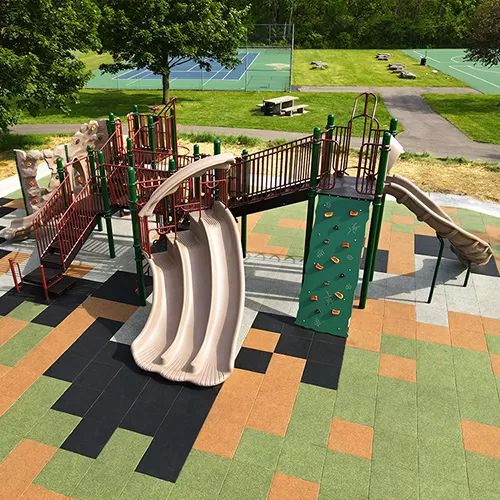
Rubber tiles are a common choice for playgrounds since they’re highly customizable and safe. Rubber tile is produced from bonded rubber. Individual square pieces are placed on the sub-base in a pattern with interlocking sides, creating a smooth surface. Due to this, rubber tile is characterized by a high accessibility level.
This surfacing material comes in various thicknesses to align with the fall height attenuation of different playground equipment. In addition, rubber tiles exist in a wealth of colors, allowing you to create exciting patterns to match the overall style of your playground.
Generally, a rubber-tile safety surface calls for medium maintenance, mainly consisting of regularly removing dirt between the tiles and cleaning the surface.
On the downside, rubber tiles are expensive to install since they require pouring a concrete base for stability. Moreover, tiles can separate and peel with age, causing a tripping hazard.
Advantages
- A variety of colors and patterns
- Durable
- Can be easily repaired
- Highly accessible
Disadvantages
- Less affordable than most other surface materials
- Requires regular upkeep
4. Rubber Mulch
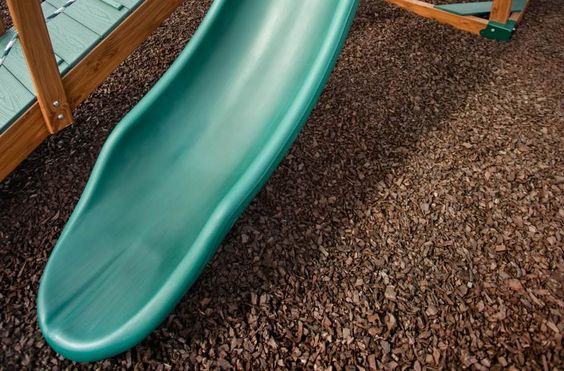
Recycled rubber mulch is a loose-fill material mainly produced from recycled tires, making it environmentally friendly. The texture and shape of rubber mulch pieces resemble wood chips. This type of safety surfacing can come in a multitude of colors and ensures high-level shock absorption. In addition, loose-fill rubber mulch is considered one of the most cost-effective playground surfaces.
Like other loose-fill materials, rubber mulch can be easily displaced, which requires regular monitoring of its depth and topping it up to ensure proper fall height attenuation. Alternatively, you can add rubber mats or tiles to high-traffic areas to provide better bounce protection and keep pieces in place.
Rubber mulch can limit accessibility for children on mobility devices and those with walking issues.
Advantages
- A variety of colors
- Highly impact-absorbent
- Sustainable
- Drains well
- Doesn’t cause splinters
- Affordable
Disadvantages
- Can conceal small objects, including hazardous ones
- Poor accessibility
- Requires routine maintenance
5. Synthetic Turf
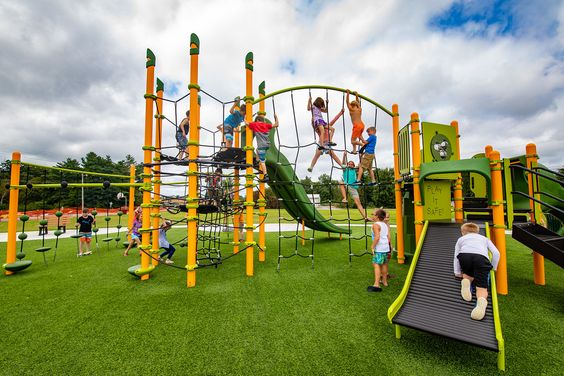
Synthetic turf is a unitary material looking like natural grass. However, unlike real grass, it can’t be torn up or provide home to different bugs, making it one of the safest playground surfaces. Moreover, it does a great job absorbing impact and is quite comfortable for kids with disabilities to cross over.
A popular choice for nature-themed playgrounds, synthetic turf is renowned for its long-lasting value and cost-effectiveness.
Synthetic turf sometimes contains the so-called infill — quartzite or rubber granules — between the “grass blades” to prevent them from flattening. However, infill can spill over, making it uncomfortable for little ones to run and play. Also, keep in mind that infill shouldn’t be used in play areas for infants and toddlers. And although there are non-infill options, they’re likely to flatten over time.
The upkeep of synthetic turf boils down to removing debris and dirt from the surface.
Advantages
- Natural look
- Easy maintenance
- Highly accessible
- Highly impact-absorbent
Disadvantages
- High cost
- Requires more maintenance than other unitary options
- Absorbs heat, which might be an issue on a hot day
- Unless installed properly, rolls in turf could lead to trips
What is the safest playground surface?
Perhaps the best solution for playground safety surfaces is engineered wood fiber (EWF). This material has excellent shock absorbent properties and is easy to install.
The other materials we’ve looked at are also popular playground options. For example, poured rubber is easier to maintain and provides excellent cushioning. Meanwhile, rubber mats made from recycled tires are great for high-use areas and provide extra protection, while synthetic turf is a good solution if the playground is used by kids with disabilities.
Therefore, when considering the question “What is the safest surface to use under playground equipment?”, you should also take into account the requirements, budget, and maintenance capabilities, as well as the age & needs of the children who will be using that playground.
Contact us today and our team will help you choose the best rubber surfacing option for your specific case.
Materials to avoid
Below is a list of unsafe materials for children and those violating ADA, so you should avoid using them when building a playground.
Concrete
Concrete is an extremely hard surface that can cause a traumatic brain injury after a fall.
Pea gravel
Besides offering poor fall protection, this material can cause a choking hazard. In addition, it can be abused by unruly children.
Grass
Although the grass feels soft, it isn’t thick enough to cushion a fall.
Wooden boards
Wooden boards can’t provide proper fall cushioning. In addition, they can cause splinters and get slippery in wet weather.
Dirt
Besides providing zero fall protection, dirt eventually wears down, resulting in an uneven surface that can lead to tripping and injuries.
Playground sand
Although it’s an appropriate surface for playgrounds according to ASTM and CPSC, you’ll need 9 inches deep sand for a fall height of just 4 feet. Also, it doesn’t meet the ADA accessibility standards.
Playground safety standards
Playground safety standards have been established to help playground owners ensure playground’s safety. Not all U.S. states have enacted legislation to enforce playground safety standards. Still, many have adopted guidelines created by the U.S. Consumer Product Safety Commission (CPSC).
Although following playground safety standards is optional in some states, playground owners can remain liable for injuries happening on their playgrounds. Keeping to safety standards is vital if you focus on protecting kids and your business. Let’s take a closer look at the essential playground surfacing standards that can serve as guidelines for creating safe playground environments.
1. CPSC
The Consumer Product Safety Commission (CPSC) produced the Public Playground Safety Handbook with tips on building safe playgrounds, including guidelines on safety surfacing. Here are some key points to consider:
- surfacing should include a material tested to meet ASTM F1292 standards
- loose-fill surfacing compresses 25% over time, so each playground owner needs to plan regular refills
- loose-fill materials require routine maintenance to ensure the depth is at a safe level
- you should add a perimeter to keep loose-fill surfacing in place
- good drainage is important, so playground owners need to take care that water doesn’t pool anywhere on the playground
- the layer of the loose-fill material should be no less than 9 inches thick.
2. ASTM International
The American Society for Testing and Materials (also known as ASTM International) is a standards organization that develops voluntary consensus standards for a broad range of products, materials, systems, and services to ensure safety and quality.
The organization has established a number of playground standards, the ASTM’s F1292 standard being the key for playground surfacing. It’s been used as the go-to method of assessing loose-fill materials.
The method involves two measurements — a critical drop height test done in a laboratory and testing of the installed surface performance. The F1292 standard contains requirements for satisfying impact attenuation performance and provides a way of identifying the material’s capabilities with the help of special equipment.
3. ADA
The Americans with Disabilities Act (ADA) bans discrimination based on disability, promoting the idea that everyone should receive equal opportunities. Any newly built or altered playground, public or commercial, is required to comply with this act. This is what ADA says about playground surfacings:
- playground owners are obliged to create routes in and around playgrounds accessible for mobility devices
- surfaces must meet ASTM F1951-99 specification, which tests the accessibility of a surface by assessing the force one must use to move a mobility device across it
- surfacing within play equipment areas must meet the ASTM F1292 standard to ensure it is impact-attenuating
- playground owners should plan routine inspections and maintenance of surfacing to stay in compliance, with maintenance frequency depending on the type of material
4. CSA
The Canadian Standards Association (CSA) is an organization that develops standards in 57 areas, including recommendations for playground safety surfacing. Below are some of them:
- fall height of play equipment should be measured from the tops of barriers
- surfacing must extend at least 6 feet in all directions from the play equipment
- safety surfacing should be regularly inspected for hazardous objects
Final thoughts
Kids’ safety is the most vital thing to focus on when building or revamping a playground, a safe surface being the number one aspect to consider. The choice is vast, and while each safety surface — poured rubber, synthetic turf, engineered wood fiber, mulch — has its advantages and disadvantages, your choice should only depend on your specific needs and budget.
